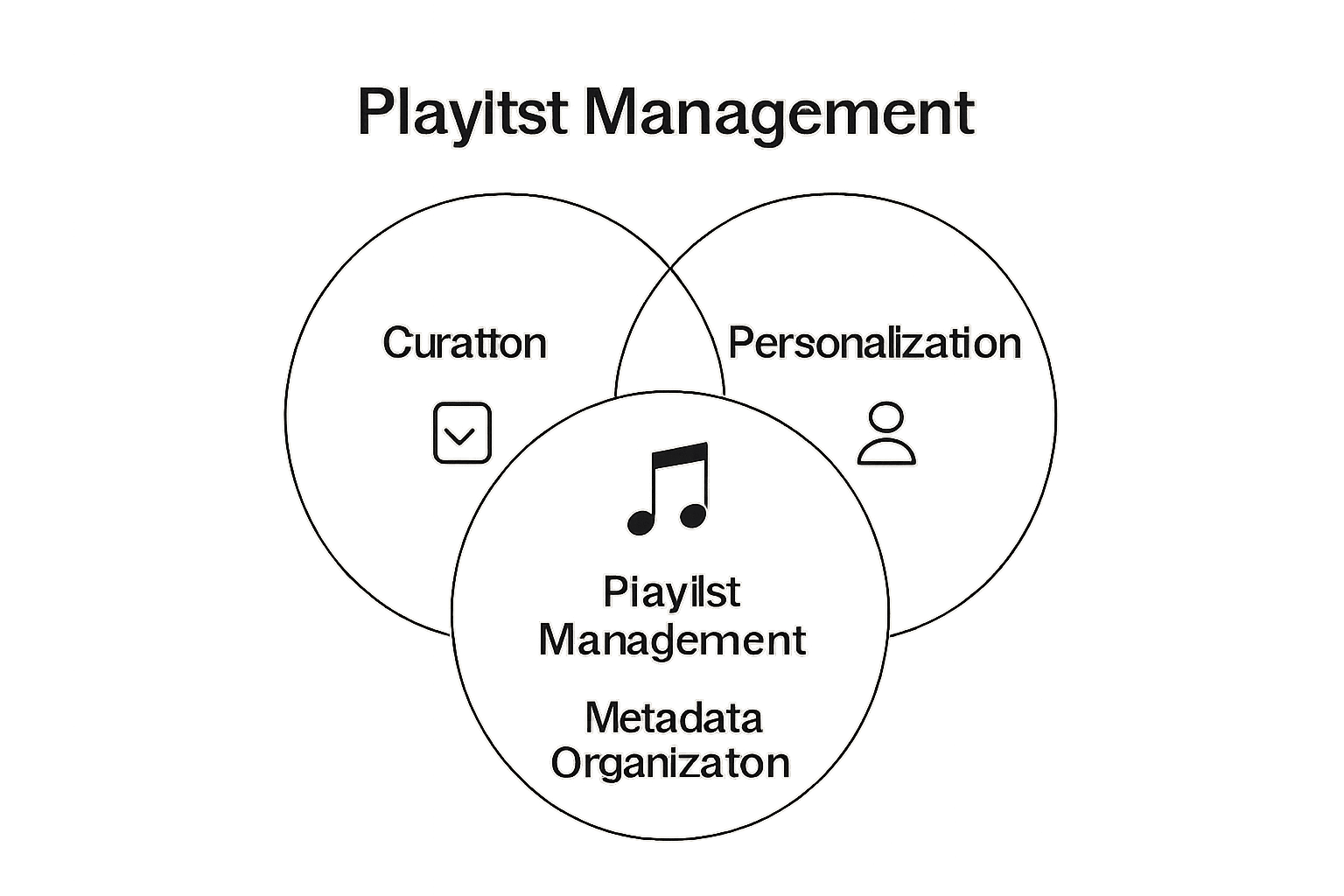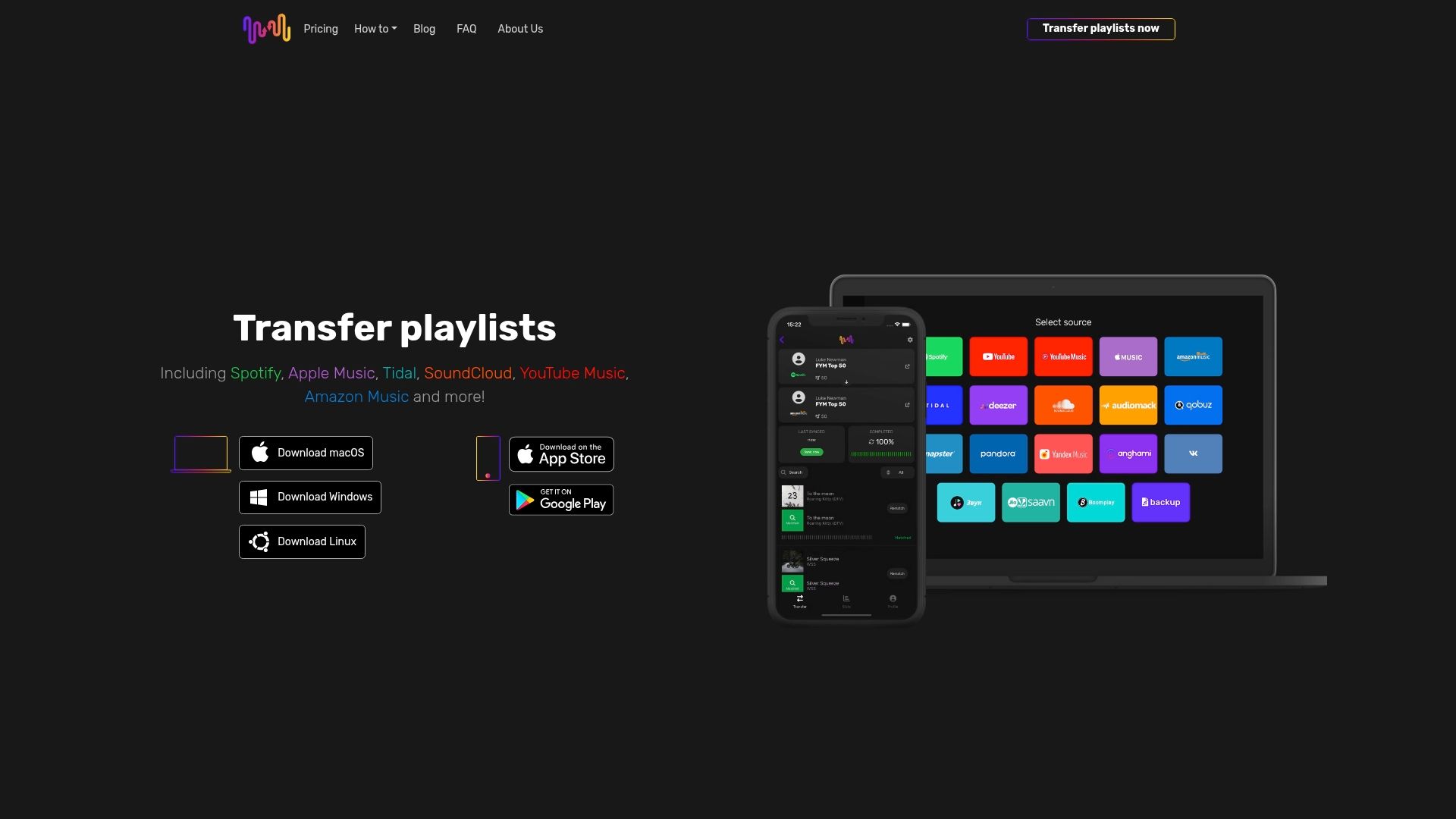Playlist management sounds simple at first. Most people imagine dragging songs into a folder and hitting play. But get this. Over 60 percent of streaming service users say custom playlists make them stick around and listen longer. That means playlist management is not just about sorting songs, it is about building a music experience so personal and potent that it keeps people coming back for more.
Table of Contents
- Defining Playlist Management: Key Concepts And Terminology
- The Importance Of Playlist Management In Music Streaming
- How Playlist Management Works: Tools And Techniques
- Real-World Applications Of Effective Playlist Management
- Challenges And Best Practices In Playlist Management
Quick Summary
| Takeaway | Explanation |
|---|---|
| Effective playlists enhance user experience. | Carefully curated playlists resonate emotionally and reflect personal experiences, transforming music listening into an interactive journey. |
| Playlist management is crucial for streaming services. | Robust playlist features can boost user engagement and retention, differentiating platforms in a competitive market. |
| Technology facilitates advanced playlist management. | Using intelligent algorithms and syncing tools, users can optimize and personalize their music collections across platforms. |
| Strategic curation aids in emotional care. | In healthcare, tailored playlists can reduce anxiety and support mental health by influencing emotional states positively. |
| Maintain coherence during playlist transfers. | Ensuring integrity of playlists during platform changes prevents data loss and maintains the personalized music experience. |
Defining Playlist Management: Key Concepts and Terminology
Playlist management represents a sophisticated digital music organization strategy that goes far beyond simply collecting songs. At its core, it involves the systematic process of curating, arranging, and maintaining collections of audio tracks across various digital platforms.
Understanding the Fundamentals
Playlist management encompasses several critical components that transform random song collections into meaningful musical experiences. Research in digital music consumption reveals that effective playlist management involves multiple interconnected processes:
- Curation: Thoughtfully selecting and sequencing tracks that create a cohesive listening journey
- Metadata Organization: Categorizing songs using descriptive information like genre, mood, tempo, and artist
- Personalization: Tailoring playlists to individual preferences and listening habits
The fundamental goal of playlist management is to provide users with a seamless, personalized music experience that adapts to their evolving tastes and emotional states.
 This process transforms passive music consumption into an interactive, dynamic engagement.
This process transforms passive music consumption into an interactive, dynamic engagement.
Technical and Emotional Dimensions
Playlist management is not merely a technical exercise but a deeply personal art form. Users create soundtracks for specific moments, emotional states, and life experiences. Whether compiling workout motivation tracks, romantic dinner playlists, or road trip compilations, each playlist tells a unique story.
Technical aspects of playlist management include:
- Accurate song matching across different streaming platforms
- Preserving playlist order and structure during transfers
- Maintaining metadata integrity during music library migrations
By understanding these key concepts, users can optimize their music experience and create more meaningful digital music collections.
Below is a table outlining the key components of playlist management and their specific roles. This helps clarify the foundational elements that make up an effective playlist management system.
| Component | Description |
|---|---|
| Curation | Selecting and sequencing tracks for a cohesive listening journey |
| Metadata Organization | Categorizing songs by genre, mood, tempo, and artist |
| Personalization | Tailoring playlists to fit individual preferences and habits |
| Song Matching | Ensuring accurate identification of tracks across platforms |
| Playlist Structure | Preserving song order and arrangement during transfers |
| Metadata Integrity | Maintaining correct song information during migrations |
| For those looking to streamline their music transfer process, advanced playlist management tools provide comprehensive solutions that preserve the essence of personal music libraries. |
The Importance of Playlist Management in Music Streaming
Playlist management has emerged as a critical component in modern music consumption, transforming how users interact with digital audio platforms. Research in music technology demonstrates that effective playlist management significantly enhances user engagement and satisfaction across streaming services.
User Experience and Personal Connection
At its essence, playlist management enables listeners to create personalized musical landscapes that reflect individual emotions, experiences, and preferences. This goes beyond simple song selection and becomes a form of personal expression. Users craft intricate soundtracks that capture specific moods, moments, and memories, turning music streaming from a passive activity into an interactive, deeply personal experience.

Key benefits of sophisticated playlist management include:
- Creating emotional resonance through carefully curated track sequences
- Enabling quick access to mood-specific music collections
- Facilitating seamless transitions between different musical styles and genres
Strategic Importance for Music Platforms
For streaming services, playlist management represents more than a user feature—it is a strategic tool for user retention and engagement. Platforms that offer robust playlist management capabilities can differentiate themselves in a competitive market. These tools provide users with a sense of ownership and control over their musical experience, encouraging longer listening sessions and increased platform loyalty.
Technical advantages of advanced playlist management include:
- Intelligent recommendation algorithms
- Cross-platform synchronization capabilities
- Sophisticated metadata tracking and organization
By exploring comprehensive playlist transfer solutions, users can maximize their musical experience across different streaming ecosystems. The ability to maintain playlist integrity during platform transitions represents a significant advancement in digital music consumption, empowering listeners to curate their musical journey without technological barriers.
How Playlist Management Works: Tools and Techniques
Playlist management represents a sophisticated technological ecosystem that combines user creativity with advanced digital infrastructure. Automated playlist generation technologies leverage complex algorithms to transform how music lovers organize and interact with their audio collections.
Technological Infrastructure
Modern playlist management tools operate through intricate systems that enable seamless music organization and discovery. These platforms utilize multiple technological components to provide users with intuitive, powerful music management experiences. The core technological architecture includes:
- Advanced metadata analysis engines
- Machine learning recommendation systems
- Cross platform synchronization protocols
- Intelligent track matching algorithms
Users can now manipulate their music libraries with unprecedented precision, creating highly personalized audio experiences that adapt to individual preferences and listening habits.
User Interface and Interaction Techniques
The most effective playlist management tools prioritize user experience through sophisticated yet accessible interfaces. Research in digital music interaction demonstrates that successful platforms offer:
- Drag and drop playlist editing
- Real time track recommendation features
- Collaborative playlist creation options
- Intuitive tagging and categorization systems
These interactive techniques transform playlist management from a mundane organizational task into an engaging, creative process. Users can now curate musical experiences that reflect their unique emotional landscapes and listening preferences.
For music enthusiasts seeking comprehensive solutions, Free Your Music offers an ultra simple transfer platform that simplifies playlist management across multiple streaming services. By understanding these sophisticated tools and techniques, users can unlock new dimensions of musical exploration and personal expression.
Real-World Applications of Effective Playlist Management
Playlist management has transcended its original purpose of music organization, emerging as a powerful tool with diverse applications across multiple professional and personal domains. Clinical research in music therapy demonstrates the profound impact of strategic playlist curation in therapeutic and emotional contexts.
Healthcare and Therapeutic Environments
In medical settings, playlist management serves as a nuanced intervention for patient care. Healthcare professionals now recognize music as a powerful therapeutic instrument, utilizing carefully curated playlists to:
- Reduce patient anxiety during medical procedures
- Support emotional regulation for individuals with mental health challenges
- Provide cognitive stimulation for patients with neurological disorders
- Create calming environments in high stress medical settings
These targeted musical interventions showcase how sophisticated playlist management can directly influence physiological and psychological well being.
Professional and Commercial Applications
Brands and businesses have rapidly adopted playlist management as a strategic communication tool. Marketing research reveals that companies leverage music to shape customer experiences and reinforce brand identity. Retail spaces, restaurants, and corporate environments now use intelligent playlist management to:
- Create specific atmospheric moods
- Enhance customer engagement
- Influence purchasing behaviors
- Communicate brand personality through musical selection
For professionals seeking seamless music ecosystem management, exploring playlist transfer solutions can provide comprehensive tools to navigate complex digital music landscapes. The ability to strategically manage and transfer playlists across platforms represents a critical skill in our increasingly connected musical world.
The table below compares the different real-world applications of effective playlist management, organizing the specific uses and objectives in healthcare versus commercial environments.
| Application Area | Primary Uses | Objectives |
|---|---|---|
| Healthcare | Reduce anxiety, support emotional regulation, cognitive stimulation, create calming environments | Enhance patient well-being, emotional support |
| Professional/Commercial | Create moods, enhance engagement, influence purchasing, display brand personality | Improve customer experience, reinforce brand |
Challenges and Best Practices in Playlist Management
Playlist management continues to evolve as a complex digital discipline, presenting unique challenges and opportunities for music enthusiasts and professionals alike. Research on digital music platforms highlights the intricate balance between technological capabilities and user expectations.
Technical and Metadata Challenges
Navigating the complex landscape of playlist management requires addressing several critical technical challenges:
- Ensuring accurate song metadata across different streaming platforms
- Managing copyright and licensing complexities
- Maintaining playlist integrity during cross platform transfers
- Handling inconsistent audio file formats and quality
These technical hurdles demand sophisticated solutions that can seamlessly bridge gaps between different musical ecosystems. Users must develop strategic approaches to overcome platform specific limitations and maintain the integrity of their musical collections.
User Experience and Optimization Strategies
Effective playlist management extends beyond technical capabilities, focusing on creating meaningful musical experiences. Best practices for users include:
- Regularly updating and refreshing playlist contents
- Utilizing algorithmic recommendations strategically
- Creating diverse and dynamic playlist collections
- Implementing thoughtful organization methods
- Balancing algorithmic suggestions with personal curation
Professional music curators and enthusiasts recognize that playlist management is an ongoing process of refinement and personal expression. Each playlist represents a unique musical journey that requires continuous attention and creative input.
Exploring comprehensive playlist transfer solutions can help users navigate these challenges, providing tools that simplify the complex landscape of modern music management. By understanding and implementing these best practices, music lovers can transform playlist management from a technical task into a truly personalized musical experience.
Transform Your Playlist Management Experience with Effortless Transfers
Are you tired of struggling with lost playlists, mismatched songs, and hours spent rebuilding your music collections each time you switch streaming services? The article highlighted the pain of maintaining playlist integrity, dealing with metadata challenges, and the emotional connection we build with our carefully curated playlists. Now you can turn that frustration into freedom.

Try FreeYourMusic.com and instantly streamline your playlist management. Move your entire music library between platforms like Spotify, Apple Music, Tidal, and more with just a few clicks. You will be able to preserve playlist order, accurate song matching, and metadata so you never lose your favorite musical moments. Let automated sync, cloud backup, and intuitive management reshape your music journey. Take control of your collections and discover the easiest way to transfer your playlists effortlessly across services. Sign up now and experience hassle free, secure transfers today.
Frequently Asked Questions
What is playlist management?
Playlist management is the systematic process of curating, arranging, and maintaining collections of audio tracks across digital platforms, transforming random song collections into meaningful musical experiences.
Why is playlist management important for music streaming services?
Effective playlist management enhances user engagement and satisfaction, allowing listeners to create personalized musical landscapes that reflect individual emotions and preferences.
What are some key components of playlist management?
Key components include curation (selecting and sequencings tracks), metadata organization (categorizing songs by genre, mood, etc.), and personalization (tailoring playlists to individual listening habits).
How can users optimize their playlist management experience?
Users can optimize their playlist management by regularly updating playlists, utilizing algorithmic recommendations, creating diverse collections, and implementing thoughtful organization methods.




